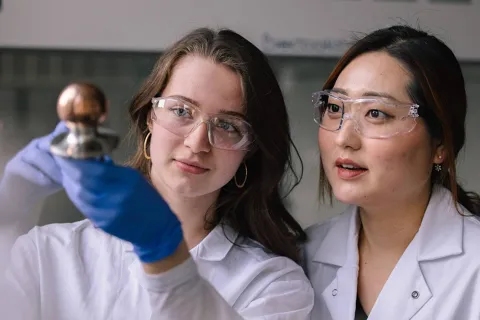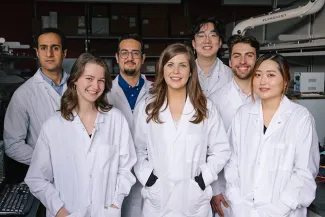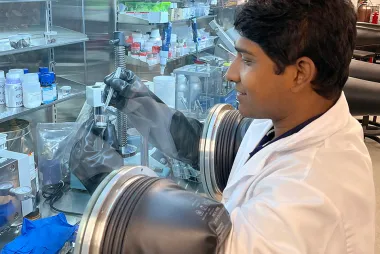UBC Engineers develop nano-copper to quickly kill superbugs
“By using this new formulation, we’re killing pathogens before patients become infected and need to use antibiotics against them, slowing the rise of antibiotic resistance."

A new copper coating that kills bacteria quicker and in greater amounts than current formulations could soon be available for hospitals and other high-traffic facilities.
Although current formulations made of pure copper are antibacterial and self-sanitizing, they kill certain types of bacteria with a thicker cell wall (Gram-positive bacteria), more slowly than bacteria with a thinner cell wall (Gram-negative).
A team of UBC researchers led by Dr. Amanda Clifford (she/her), an Assistant Professor in the Department of Materials Engineering, have designed a nano-copper coating that includes bacteria-killing nanoscale features and zinc. The nanoscale features are tiny bumps that can kill bacteria by rupturing their cell wall. Zinc, which is also antibacterial, selectively oxidizes in the presence of copper and helps kill bacteria more quickly compared to pure copper alone.
“Use of our coating could significantly reduce the incidence of contracting bacterial infections from high-touch surfaces in healthcare facilities, such as doorknobs and elevator buttons, since it kills bacteria using multiple approaches,” says Dr. Clifford. “As it contains less copper than other existing coatings or whole copper parts, it would also be cheaper to make.”
The team found that the material took just one hour to kill 99.7 per cent of Staphylococcus aureus—a Gram-positive pathogen commonly responsible for hospital-acquired infections— compared with two hours for pure copper.

“Not only does this coating kill pathogens faster than pure copper, it helps ensure antibiotics remain effective,” said Dr. Clifford. “By using this new formulation, we’re killing pathogens before patients become infected and need to use antibiotics against them, slowing the rise of antibiotic resistance.”
The researchers have filed a provisional patent for the coating and fabrication process, which is described in a new paper in Advanced Materials Interfaces.
“This is currently targeted for hospitals and health care settings because these locations are where the antibiotic-resistant pathogens, such as methicillin-resistant Staphylococcus aureus (MRSA), are an issue. We also don’t want to be at a place where we can't use antibiotics,” says Dr. Clifford.
The team plans to further evaluate the material against other pathogens, such as viruses, with hopes to eventually commercialize their work.
The work is funded in partnership with Teck Resources Limited, which has installed copper surfaces on high-contact surfaces in faculty of applied science buildings at UBC through its Copper & Health program.
“Installing antimicrobial copper on high-touch surfaces is already a proven way to enhance safety, and Teck is proud to partner and support research led by UBC that has the potential to make communities even safer,” says Don Lindsay, Teck president and CEO.
“Life-saving inventions of this nature are only possible because this great research is funded by industry partners like Teck,” said Dr. James Olson, Dean, Faculty of Applied Science. “As the Faculty looks to make its impact on the world by aggressively tackling climate change, we’re pleased that our researchers are supported by bold R&D investments from the private sector.”




